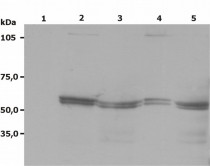ARG63066
anti-Lyn antibody [LYN-01]
anti-Lyn antibody [LYN-01] for ICC/IF,Immunoprecipitation,Western blot and Human,Mouse,Rat
Signaling Transduction antibody; Src Family Protein Tyrosine Kinases antibody

1
Overview
| Product Description | Mouse Monoclonal antibody [LYN-01] recognizes Lyn |
|---|---|
| Tested Reactivity | Hu, Ms, Rat |
| Tested Application | ICC/IF, IP, WB |
| Specificity | The clone LYN-01 reacts with Lyn (p56/p53), a non-receptor Src-family tyrosine kinase expressed in hematopoietic tissues. |
| Host | Mouse |
| Clonality | Monoclonal |
| Clone | LYN-01 |
| Isotype | IgG1 |
| Target Name | Lyn |
| Antigen Species | Human |
| Immunogen | Bacterially expressed recombinant fragment of human Lyn (aa 8 - 238). |
| Conjugation | Un-conjugated |
| Alternate Names | JTK8; Lck/Yes-related novel protein tyrosine kinase; V-yes-1 Yamaguchi sarcoma viral related oncogene homolog; p56Lyn; Tyrosine-protein kinase Lyn; p53Lyn; EC 2.7.10.2 |
Application Instructions
| Application Suggestion |
|
||||||||
|---|---|---|---|---|---|---|---|---|---|
| Application Note | WB: Antibody Incubation: 60 min. Sample preparation: Resuspend approx. 50 mil. cells in 1 ml cold lysis buffer (1% laurylmaltoside in 20 mM Tris/Cl, 100 mM NaCl pH 8.2, 50 mM NaF including Protease inhibitor Cocktail). Incubate 60 min on ice. Centrifuge to remove cell debris. Mix lysate (1:1) with non-reducing SDS-PAGE sample buffer. Application note: Non-reducing condition. SDS-PAGE (12% separating gel). * The dilutions indicate recommended starting dilutions and the optimal dilutions or concentrations should be determined by the scientist. |
||||||||
| Positive Control | WB: RBL rat basophilic leukemia cells, Jurkat, A431 and U-937 |
Properties
| Form | Liquid |
|---|---|
| Purification | Purified from hybridoma culture supernatant by protein A-affinity chromatography. |
| Purity | > 95% (by SDS-PAGE) |
| Buffer | PBS (pH 7.4) and 15 mM Sodium azide |
| Preservative | 15 mM Sodium azide |
| Concentration | 1 mg/ml |
| Storage Instruction | For continuous use, store undiluted antibody at 2-8°C for up to a week. For long-term storage, aliquot and store at -20°C or below. Storage in frost free freezers is not recommended. Avoid repeated freeze/thaw cycles. Suggest spin the vial prior to opening. The antibody solution should be gently mixed before use. |
| Note | For laboratory research only, not for drug, diagnostic or other use. |
Bioinformation
| Database Links | |
|---|---|
| Gene Symbol | LYN |
| Gene Full Name | LYN proto-oncogene, Src family tyrosine kinase |
| Background | Lyn is a Src-family protein tyrosine kinase that is predominantly expressed in hematopoietic cells. It is associated with a number of cell surface receptors including the B cell antigen receptor (BCR) and Fc receptors. Upon their triggering, Lyn phosphorylates subunits of these receptors in a cholesterol-dependent manner, utilizing the plasma membrane lipid raft system. The phosphorylated intracellular domains of the receptors are accessible for cytoplasmic Syk tyrosine kinase, which is activated by Lyn-mediated phosphorylation and which transduces the signal to downstream adaptors. Lyn is abnormally distributed in acute myeloid leukemia cells and seems to be a novel pharmacologic target of this disease. |
| Function | Non-receptor tyrosine-protein kinase that transmits signals from cell surface receptors and plays an important role in the regulation of innate and adaptive immune responses, hematopoiesis, responses to growth factors and cytokines, integrin signaling, but also responses to DNA damage and genotoxic agents. Functions primarily as negative regulator, but can also function as activator, depending on the context. Required for the initiation of the B-cell response, but also for its down-regulation and termination. Plays an important role in the regulation of B-cell differentiation, proliferation, survival and apoptosis, and is important for immune self-tolerance. Acts downstream of several immune receptors, including the B-cell receptor, CD79A, CD79B, CD5, CD19, CD22, FCER1, FCGR2, FCGR1A, TLR2 and TLR4. Plays a role in the inflammatory response to bacterial lipopolysaccharide. Mediates the responses to cytokines and growth factors in hematopoietic progenitors, platelets, erythrocytes, and in mature myeloid cells, such as dendritic cells, neutrophils and eosinophils. Acts downstream of EPOR, KIT, MPL, the chemokine receptor CXCR4, as well as the receptors for IL3, IL5 and CSF2. Plays an important role in integrin signaling. Regulates cell proliferation, survival, differentiation, migration, adhesion, degranulation, and cytokine release. Down-regulates signaling pathways by phosphorylation of immunoreceptor tyrosine-based inhibitory motifs (ITIM), that then serve as binding sites for phosphatases, such as PTPN6/SHP-1, PTPN11/SHP-2 and INPP5D/SHIP-1, that modulate signaling by dephosphorylation of kinases and their substrates. Phosphorylates LIME1 in response to CD22 activation. Phosphorylates BTK, CBL, CD5, CD19, CD72, CD79A, CD79B, CSF2RB, DOK1, HCLS1, LILRB3/PIR-B, MS4A2/FCER1B, PTK2B/PYK2, SYK and TEC. Promotes phosphorylation of SIRPA, PTPN6/SHP-1, PTPN11/SHP-2 and INPP5D/SHIP-1. Mediates phosphorylation of the BCR-ABL fusion protein. Required for rapid phosphorylation of FER in response to FCER1 activation. Mediates KIT phosphorylation. Acts as an effector of EPOR (erythropoietin receptor) in controlling KIT expression and may play a role in erythroid differentiation during the switch between proliferation and maturation. Depending on the context, activates or inhibits several signaling cascades. Regulates phosphatidylinositol 3-kinase activity and AKT1 activation. Regulates activation of the MAP kinase signaling cascade, including activation of MAP2K1/MEK1, MAPK1/ERK2, MAPK3/ERK1, MAPK8/JNK1 and MAPK9/JNK2. Mediates activation of STAT5A and/or STAT5B. Phosphorylates LPXN on 'Tyr-72'. Kinase activity facilitates TLR4-TLR6 heterodimerization and signal initiation. [UniProt] |
| Highlight | Related Antibody Duos and Panels: ARG30169 Src Family Protein Tyrosine Kinases Antibody Panel Related products: Lyn antibodies; Lyn ELISA Kits; Lyn Duos / Panels; Anti-Mouse IgG secondary antibodies; |
| Research Area | Signaling Transduction antibody; Src Family Protein Tyrosine Kinases antibody |
| Calculated MW | 59 kDa |
| PTM | Ubiquitinated by CBL, leading to its degradation. Ubiquitination is SH3-dependent. Autophosphorylated. Phosphorylated on tyrosine residues in response to KIT signaling. Phosphorylation at Tyr-397 is required for optimal activity. Phosphorylation at Tyr-508 inhibits kinase activity. Phosphorylated at Tyr-508 by CSK. Dephosphorylated by PTPRC/CD45. Becomes rapidly phosphorylated upon activation of the B-cell receptor and the immunoglobulin receptor FCGR1A. |
Images (1) Click the Picture to Zoom In
Customer's Feedback
Clone References










